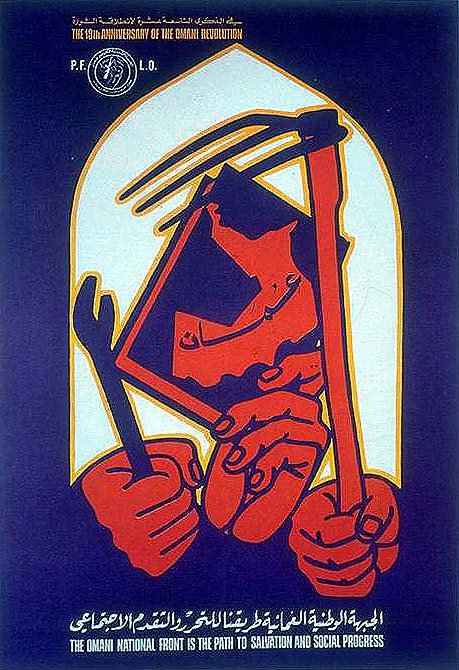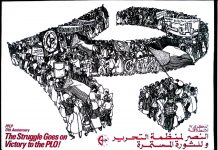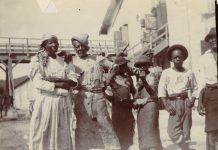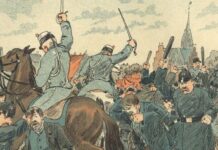Den 9. juni 1965 startede den folkelige bevægelse PFLO i Oman en kamp mod kolonialismen i Den arabiske Golf.
Indhold
- Forord
- English Foreword
- Leksika
- Det antikoloniale opør / The anticolonial rebellion
- Video
- Solidaritesarbejde / Solidarity work
- Oman i dag: Baggrund / Oman today: Background
- Bøger / Books
- Oprøret set fra de britiske officerers side / The rebellion from the British officer’s point of view
- Kort over Oman og det østlige Sydyemen / Map of Oman and the eastern South Yemen
Forord
I 1965 startede PFLO et oprør mod det reaktionære sultanat Oman, beliggende i det sydøstlige hjørne af den Arabiske Halvø, og øst for Yemen – se kort forneden – der siden 1850 havde været en britisk koloni. Oprøret varede i 12 år, før PFLO måtte trække sig ud af de befriede områder til Demokratisk Yemen (Sydyemen) med adskillige tusinde flygtninge. Det var en vigtig kamp mod neokolonialisme, da Oman dengang og i dag har stor strategisk betydning for vestlig imperialisme. Adskillige lande, Iran (under Shahen), Indien, Jordan m.fl. under ledelse af britiske specialstyrker, sendte tropper til at bekæmpe oprøret. Skønt oprøret for det meste er glemt, viser det store antal bøger af engelske officerer og rapporter fra militærakademier noget om revolutionens betydning, som det kan ses i afsnittet Oprøret set fra de britiske officerers side. Materialet i denne linksamling behandler situationen dengang, og hvordan det lykkedes Vesten at skabe en alliance med reaktionære monarkier og mobilisere det konservative islam imod sekulær marxisme, men forsøger også at vise den nuværende situation.
PFLO lagde stor vægt på at inddrage kvinderne i revolutionen og sikre lige rettigheder, ligesom der blev satset meget på uddannelse og sundhedsarbejde.
For dem, der vil vide mere om PFLO og befrielseskampen, vil jeg anbefale 3 pjecer på dansk, udgivet omkring 1980 af den danske solidaritetskomité KROAG, der koordinerede det nordisk solidaritetsarbejde i samarbejde med en række klunsergrupper, Ulandskunserne, Tøj Til Afrika, der havde grupper over hele landet, der indsamlede kluns og lavede loppemarkeder. Tilsvarende var der i Sverige en række Emmaus-grupper, som skaffede penge, der kunne forsyne befrielsesbevægelsen med nødvendig medicin, hospitalsudstyr, udstyr til Kvindeorganisationen OWO og lignende. Pjecerne: Revolutionen lever, Kvinder og revolution i Oman, samt Sundhedsarbejde og revolution i Oman er alle netop lagt online. Pjecerne giver også et indtryk at det ukendte danske og svenske solidaritetarbejde. Se afsnittet Det antikoloniale oprør.
Fotos er fra en postkortserie, som blev udsendt af den daværende franske solidaritetskomité CSRO. Plakaten er tegnet af den svejsiske kunstner Marc Rudin, der også har tegnet en lang rækker plakater for PFLP.
Poul Mikael Allarp,
13. juni 2015
English Foreword
In 1965 the PFLO started a rebellion against the reactionary Sultanate of Oman in the southeastern corner of the Arabian Peninsula – se map at the bottom, and since 1850 a British colony. It lasted for about 12 years, before they had to retreat to Democratic Yemen with several thousand refugees. It was a very important struggle against neocolonialism, as Oman then and today has strategic importance for western imperialism. Several countries, Iran (during the Shah), India, Jordan, and other troops leaded by British Special troops fought against the rebellion. Though the rebellion is mostly forgotten, the
big amount of books on the War written by British officers and later studies at military academies shows the importance, as seen in the section The rebellion from the British officer’s point of view. The materials in this bibliography deals with the situation then, and how the west succeded to make an alliance between reaktionary morarkies an mobilize conservative Islam against sekular marxism, but also tries to collect materials to show the contemporary situation.
For the PFLO it was very important to include the women in the struggle, and much effort was used to give education and healthwork among the people.
A Danish solidarity committee KROAG coordinated from 1972 to around 1986 the practical solidarity work between other group of people making flea markets in Denmark and Sweden. In several other countries there were solidarity work for the PFLO, but nowhere it lasted as long as in Scandinavia. Some older members of KROAG is now publishing some of the old materials online. First in Danish, but later in English.
The photos is from a serie of postcard published by the the French solidarity committee CSRO. The poster is made by the Swiss artist Marc Rudin, who also made a lot of posters for the PFLO.
Poul Mikael Allarp,
13. juni 2015
Leksika
Engelsk Wikipedia:
- Oman
- Persian Gulf
- Gulf Cooperation Council
- Arab nationalism
- Arab Nationalist Movement
- Dhofar Rebellion
- Dhofar Liberation Front
- National Democratic Front for the Liberation of Oman and the Arabian Gulf
- Popular Front for the Liberation of the Occupied Arabian Gulf
- Popular Front for the Liberation of Oman
Dansk Wikipedia: Oman
Leksikon.org: Oman
PFLO og det antikoloniale oprør
Oman’s revolutionary movement posed a mortal threat to Arabia’s royal despots. By Alice Wilson (Jacobin, September 17, 2023)
“During the 1970s, Oman had the most powerful left-wing revolutionary movement in Arabia. A British-organized counter-insurgency eventually snuffed out the movement with massive violence, but its emancipatory legacy still endures in Omani society today.”
Oman Red Scare. By Bilal Ahmed (Souciant, May 28, 2015)
“The conflict is crucial for understanding the development of the Gulf monarchies.”
The United Kingdom’s last hot war of the Cold War: Oman, 1963–75 (pdf). By Marc Devore (Cold War History, Vol. 11, No. 3, August 2011, p. 441-471)
“… the key elements contributing to the Anglo-Omani victory were the ability of British policymakers to forge an alliance of the Middle East’s conservative monarchies, their successful mobilization of conservative Islam against secular Marxism and their persistent efforts to destabilize the People’s Democratic Republic of Yemen”.
Revolutionen Lever: Befrielseskampen i Oman (København, KROAG, 1979, 74 s.)
Pjesen beskriver Oman og Befrielsesorganisationen PFLO’s historie og udvikling. Udviklingen sættes ind i den globale sammenhæng med Nixondoktrinens krise, efter Irans fald. Desuden beskrives Omans forsøg på at bekæmpe revolutionen, med hjælp fra udenlandske tropper under ledelse af Englands specialstyrker. Der er også en omtale af det praktiske solidaritetsarbejde, der blev udført af socialister og klunsergrupper i Sverige og Danmark. Nu online på pmanet.dk (Internet Archive)
Kvinden og revolutionen i Oman. Særnummer (Nyt fra Oman & Sydarabien, nr. 36, juni 1980, 52 s. Udgivet af KROAG)
Særnummeret beskriver kvindens rolle i den omanske revolution. Kvindernes deltagelse i den væbnede kamp beskrives, ligesom udviklingen af de omanske kvinders Organisation, OWO beskrives. Enlig omtales også det skandinaviske solidaritetsarbejde. Nu online på pmanet.dk (Internet Archive)
Sundhedsarbejde & befrielseskamp i Oman. Særnummer (Nyt fra Oman & Sydarabien, nr. 37, december 1980, 24 s.)
Om PFLO’s sundhedsarbejde blandt flygtninge og tidligere i de befriede områder, og betydningen for befrielseskampen. Nu online på pmanet.dk (Internet Archive)
Golfen opruster. Af Poul Mikael Allarp (Politisk Revy, årg. 23, nr. 490, 1985, s. 10)
Om oprettelsen af Golf Rådet for landene i Golfen og oprettelsen af den amerikanskledede Rapid Deployment force, RDF, efter revolutionen i Iran skal sikre en hurtig indgriben mod oprør i Golfen. Nu online på pmanet.dk (Internet Archive)
Guerrilla Warfare and Ideological Confrontation in the Arabian Peninsula: The Rebellion in Dhufar (pdf). By J.E. Peterson (World Affairs, Vol. 139, No. 4, 1977, p. 278-295)
Britain and ‘the Oman War’: An Arabian Entanglement (pdf). By J.E. Peterson (Asian Affairs, London, Vol. 7, No. 3, October 1976, p. 285-298)
Video
Videos Related to Popular Front for the Liberation of the Occupied Arabian Gulf [1968]
Videos Related to Dhofar Rebellion (1971)

Solidaritetsarbejde
Om solidaritetsarbejde se også KROAG-pjecerne i afsnittet om det antikoloniale oprør.
Leksikon.org: Komiteen for Revolutionen i Oman og den Arabiske Golf (KROAG).
Emmaus Fnysinge : Emmaus Sundsvall-Luleå 1968-1999 Läs vår historia (ESUL – Emmaus Sundsvall-Luleås biståndsfond, ca. 2000)
Kort historisk oversigt over det praktiske støttearbejde.
Tøj til Afrika (Pjece udgivet af Tøj til Afrika, 8 s., uden årstal [ca. 1982-83])
Pjece om det praktiske solidaritetsarbejde som Tøj Til Afrika, TTA, der fortæller om, hvorfor TTA støtter en række organisationer, bl.a. PFLO.
Støtte til ZANU og PFLO (Manifest, nr. 5, 23. juli 1979, s. 3)
Om TTAs støtte til ZANU og PFLO.

PFLO Posters. Made by Marc Rudin (The Palestine Poster Project Archives)
4 Posters made by the Swiss artist Marc Rudin from 1981-1987, known for his many posters made for the palestinian sisterorganisation PFLP.
Oman i dag: Baggrund
Oman Human Rights.
Links to reports and articles.
Britain mourns its favourite Middle Eastern dictator. By Khalfan al-Badwawi and Phil Miller (Declassified UK, 17 January 2020)
“The death of Sultan Qaboos of Oman, who was one of the UK government’s closest allies, has triggered an outpouring of grief among Britain’s political and military leaders, echoed across the UK media. Yet, he was little more than an autocrat.”
Oman breaks from GCC on Yemen conflict. By Giorgio Cafero (Al-Monitor, May 7, 2015)
“Oman sees Saudi Arabia’s strategy in Yemen as misguided and dangerous for the Gulf region.”
Oman: Rights Routinely Trampled. Government Critics Face Harassment, Detention. By Joe Stork (Human Rights Watch, December 19, 2014)
“The pattern of arrests and interrogations in Oman has clearly had a chilling effect on the ability of Omanis to speak out. Oman cannot claim to be a rights respecting nation when authorities routinely arrest peaceful dissenters.”
Torture in Oman. Report (Gulf Center for Human Rights, 2014-01-29)
Torture has become the state’s knee jerk response to political expression. This report documents the arsenal of torture methods in use in Oman including mock execution, beating, hooding, solitary confinement, subjection to extremes of temperature and to constant noise, abuse and humiliation.
Oman Curbs Corruption to Quell Dissent. By Ahmed Ali M. al-Mukhaini (Al-monitor, March 2013)
“Oman is actively tackling corruption in response to the 2011 Omani Spring.”
Oman and Yemen: an historic re-encounter. By Fred Halliday (British-Yemeni Society, July 2000)
“… Yemen and Oman are no strangers to each other, and the association of British observers and participants with them is a small part of a much longer history, a history that will continue as the British connection, and Britain itself, change.”
State and Bourgeoisie in the Persian Gulf. By Fareed Mohamedi (MERIP, No. 179, Volume 22, November/December 1992)
“It is a widely held myth that Gulf businessmen accumulated their fabulous wealth by using traditional commercial acumen and guile refined over generations … but most businessmen in the modern, post-oil Gulf made their money less glamorously.”

Bøger om Oman, PFLO og oprøret
Monsoon Revolution: Republicans, Sultans, and Empires in Oman, 1965-1976. By Abdel Razzaq Takriti (Oxford Historical Monographs, August 2013, 354 p.)
“The Dhufar revolution in Oman (1965-1976) was the longest running major armed struggle in the history of the Arabian Peninsula, Britain’s last classic colonial war in the region, and one of the highlights of the Cold War in the Middle East.”
Omans Insurgencies: The Sultanate’s Struggle for Supremacy. By J.E. Peterson (London, Saqi 2007, 530 p.)
“The Northern Oman or al-Jabal al-Akhdar War of the 1950s was a struggle between the forces of the old tribally based Imamate and the newer Sultanate in the northern part of the country. In the Dhufar War of the 1960s-70s an anti-Sultanate – and later Marxist – front sought secession in the south.” Until 1999, he served as the Historian of the Sultan’s Armed Forces in the Office of the Deputy Prime Minister for Security and Defence in Muscat, Sultanate of Oman.”
- Indholdsfortegnelse online (pdf)
- Se also J.E. Peterson’s own site for more material on Oman and the Gulf today: JE. Peterson
Behind the Veil in Arabia: Women in Oman. By Unni Wikan (Baltimore, John Hopkins University Press, 1982, 314 p.)
Anthropological study of women in a village in Oman. Gives a very nuanced picture of the oppression of women in a traditional society.
- Excerpt (pdf): Man becomes woman: Transsexualism in Oman as a key to gender roles (p. 338-353)
Revolutionary transformation in the Arab world. Habash and his comrades from nationalism to marxism. By Walid W. Kazziha (London, Charles Knight, 1975, 118 p.)
Arab Nationalist Movements(ANM) history from the founding in 1948 to around 1973, where ANM sease to eksist, but is continued in lokal organisations mainly in Palestine, Democratic Yemen and Oman. The book contains important backgroundmaterial for understanding the national movements in the arab verden, historical and contemporary. List of Litterature.
Arabia Without Sultans. By Fred Halliday (London, Penguin Books, 1974, 527 p.)
Classical work on the history of the Middle East. ‘The Arab Middle East is probably the most misunderstood of all colonial regions; it is the one with the longest history of contact with the imperialist west; Yet it is the one least understood.’
- Arabia without Sultans. Review by David McKnight (Australian Left Review, No. 50, 1976, p. 36-40). “My ‘book review’ has, as its main task, an account of some very important developments in the south of Arabia (defined as the peninsula including Saudi Arabia, North and South Yemen, Oman and the Trucial or Gulf States).”
- Arabia Without Sultans Revisited. By Fred Halliday (MERIP, Vol. 27, Fall 1997). “For an author to revisit a book he wrote a quarter of a century, and a half lifetime ago, is a perilous undertaking. Arabia Without Sultans was conceived of, and written, in the early 1970s, and published in 1974 in Britain, in 1975 in the US, and subsequently, in Arabic, Persian, Japanese and, in part, Turkish translations.”
Nationalisme og klassekamp i den arabiske verden. By Ahmad El Kodsy (København, Politisk Revy, 1971, 88 s.)
Med forord af Paul M. Sweezy og Harry Magdoff. En god kort indføring i den arabiske verdens historie med hovedvægt på at beskrive handelens afgørende betydning for de arabiske landes udvikling.

Oprøret set fra de britiske officerer side
SAS Operation Oman. By Colonel Jeapes (London, William Kimber, 1980, 247 p.)
“The author commanded the first full SAS squadron in Dhofar … ‘Their success in the Dhofar campaign allowed the important lesson to be learned – that the ‘historical inevitability’ of victory for Communist inspired revolutions is a myth.'”
Oman – On the Ground in Dhofar. By Dr. Geraint Hugdhes (Defence-In-Debth, February 4, 2015)
The Secret War in South Yemen, 1972-75. By Dr. Geraint Hugdhes (Defence-In-Depth, April 15, 2015)
Excerpt from “Compellence and Accommodation in Counterinsurgency Warfare : A Dissertation Presented to The Faculty of the Graduate School of Arts and Sciences, Brandeis University, Politics Department by Jacqueline L. Hazelton, August 2011. Pdf-uddrag: Part II Successful Enemy-Centric-Plus Counterinsurgency. Chapter 3 The Case Of Dhofar, Oman, 1965-1976 (p. 53-102).
How nine British heroes entered SAS legend by fighting off 400 bloodthirsty fanatics with their last bullets. By Tony Rennell (Daily Mail, 18 August 2011)
A review of SAS Operation Storm: Nine Men Against Four Hundred, by Roger Cole and Richard Belfield (Hodder & Stoughton, 2011). An example of imperialistick propaganda an heroisation of fighting popular rebellions.
Oman: The Present in the Context of a Fractured Past (pdf). By Roby C. Barrett (Joint Special Operations University, JSOU Report 11-5, August 2011, 91 p.; online at Internet Archive).
Victory in Hades : The Forgotten Wars of The Oman 1957-1959 and 1970-1976. PART 2: The Dhofar Campaign 1970-1976 (pdf). By S. Monick (Scientia Militaria, South African Journal of Military Studies, Vol. 12, No. 4, 1982, 26 p.)
The Campaign in Oman (Dhofar) seen from a military and imperialist side.
The Dhofar War (Royal Airforce Museum)
In 1962, a rebellion broke out in Oman’s Dhofar region. With British help, the Sultanate’s Armed Forces successfully defeated the rebellion by January 1976. Part of a longer session on RAF and Oman.
Brittain and Oman: The Dhofar War and its Significance. By Lieutenant Colonel John McKeown (Royal Engineers, 1981, 117 p.)
“We can be proud of the contribution of British officers and soldiers to the survival of Oman as a free nation during the Dhofar War: some of them life for ever in that remote land.”
The Desert Song Oman & Dhofar 1969-1976 (Site på Way Back Machine)
Deals with the military and strategic (Winning the peoples harts and minds) side of battling a rebellion. Made by British veterans.

Kort over Oman og det østlige Sydyemen


































